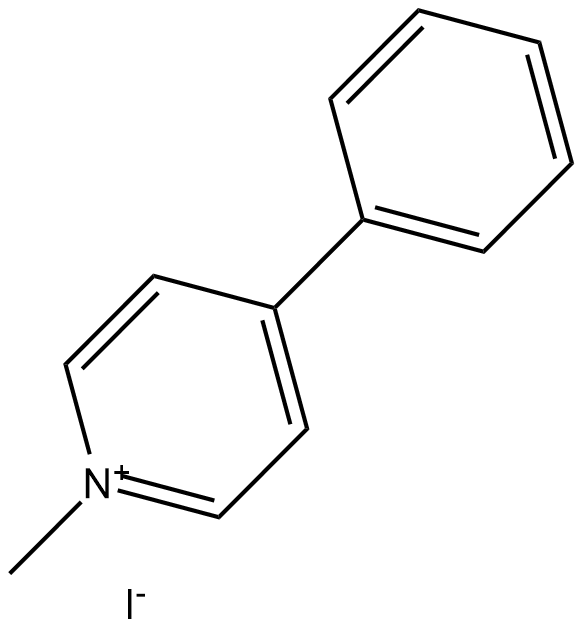MPP+ Iodide (Synonyms: N-Methyl-4-Phenylpyridinium Iodide) |
| Catalog No.GC18188 |
MPP+ 아이오딘화물(1-메틸-4-페닐피리디늄 아이오딘화물)은 신경독소 MPTP의 독성 대사산물로, 특정하게 두파상체 내 도파민성 신경세포를 파괴하여 인공적으로 파킨슨 증후군을 유발하는 체외 모델에서 성공적으로 사용되었습니다.
Products are for research use only. Not for human use. We do not sell to patients.

Cas No.: 36913-39-0
Sample solution is provided at 25 µL, 10mM.
MPP+ Iodide (1-methyl-4-phenylpyridinium iodide) is a toxic metabolite of the neurotoxin MPTP, and has successfully induced Parkinson-like syndromes in an in vitro model by selectively destroying dopaminergic neurons in substantia nigra.[1]
In vitro efficacy test it shown that when SH-SY5Y cells were exposed to MPP+ Iodidein the range of 1–100 M for 3–24 h, MPP+ Iodide exhibited a dose-time dependent cytotoxicity.[1] In vitro experiment it indicated that SH-SY5Y cells were treated with 0.2, 0.4, 0.8, or 1.0 mM MPP + for 24 h, MPP+ Iodide could significantly reduce cell viability in a dose-dependent manner.[2] In vitro, treatment with 1-7.5 mM of MPP+ Iodide dose-dependently increased the neurodegeneration in the L1 larvae of BZ555 worms. The percentages of worms exhibiting neurodegeneration after treatment with 1 mM, 2.5 mM, 5 mM and 7.5 mM MPP+ Iodide were 24%, 27%, 67% and 87%, respectively.[3] Both TSM1 and primary neurons were treated with 0.1 to 2 mM of MPP+ Iodide induced neuronal cell death in a concentration dependent manner in vitro. TSM1 cells and primary neurons were treated with 400 µM MPP+ Iodide decreased by 60% and 80% the cell viability as compared to the control, respectively.[4] In vitro to test the role of MAC1 in MPTP/MPP+-induced neurotoxicity, neuron-glia cultures were treated with 0.125, 0.25, or 0.5 μM of MPP+ Iodidefound that MPP+-induced DAergic neurotoxicity in neuron-glia cultures was attenuated in the absence of MAC1.[5]
In vivo study indicated that intranigral infusion of 3 µg/µl MPP+ Iodideinduced oxidative injury in nigrostriatal dopaminergic system of rat brain; and autophagy is pro-death in the MPP+-induced oxidative injury.[6]
References:
[1].Reudhabibadh R, et al. Suppressing Cdk5 Activity by Luteolin Inhibits MPP+-Induced Apoptotic of Neuroblastoma through Erk/Drp1 and Fak/Akt/GSK3β Pathways. Molecules. 2021 Feb 28;26(5):1307.
[2].Yan J, et al. Artemisinin attenuated oxidative stress and apoptosis by inhibiting autophagy in MPP+-treated SH-SY5Y cells. J Biol Res (Thessalon). 2021 Feb 25;28(1):6.
[3].Anjaneyulu J, et al. Differential effect of Ayurvedic nootropics on C. elegans models of Parkinson's disease. J Ayurveda Integr Med. 2020 Oct-Dec;11(4):440-447.
[4].Petit-Paitel A, et al. Involvment of cytosolic and mitochondrial GSK-3beta in mitochondrial dysfunction and neuronal cell death of MPTP/MPP-treated neurons. PLoS One. 2009;4(5):e5491.
[5].Hu X, et al. Macrophage antigen complex-1 mediates reactive microgliosis and progressive dopaminergic neurodegeneration in the MPTP model of Parkinson's disease. J Immunol. 2008 Nov 15;181(10):7194-204.
[6].Hung KC, et al. Roles of autophagy in MPP+-induced neurotoxicity in vivo: the involvement of mitochondria and α-synuclein aggregation. PLoS One. 2014 Mar 19;9(3):e91074.
Average Rating: 5 (Based on Reviews and 2 reference(s) in Google Scholar.)
GLPBIO products are for RESEARCH USE ONLY. Please make sure your review or question is research based.
Required fields are marked with *




